This couple's DIY 'Skoolie' bus conversion took 4 years and cost $20,000. See inside their 'mid-century' dream home.
Joshua Zitser

- Anna Morgan and Joshua Beaman bought a 30-foot school bus for $4,000.
- They spent four years renovating it, using carpentry and bargain-hunting skills to save money.
Anna Morgan and Joshua Beaman have worked together for about eight years doing finish carpentry.
Being tradespeople helped them when they set out to renovate an old school bus.
It meant they didn't need to outsource work and could save money on the project. But they also saved a lot by being resourceful, using leftover wood and finding deals on Craigslist and at estate sales.
Look inside "The Haus Moves" and see how Beaman and Morgan completed their dream project.
Joshua Beaman and Anna Morgan bought an old school bus for $4,000.
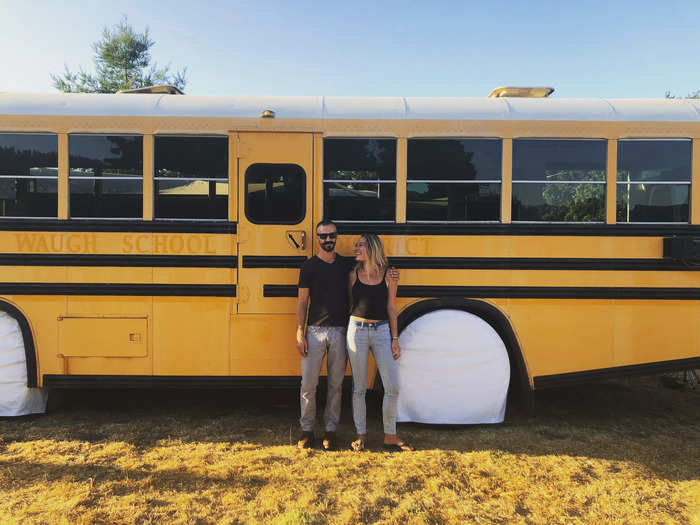
Seeing Morgan's brother renovate a school bus inspired the couple to look for a Skoolie of their own.
After a long search, they found the perfect bus on Craiglist, which cost them just $4,000.
It was from a school district and was in relatively good condition. Plus, it had a reasonably low mileage of about 64,000 miles.
It was the perfect size and 'built like a tank.'
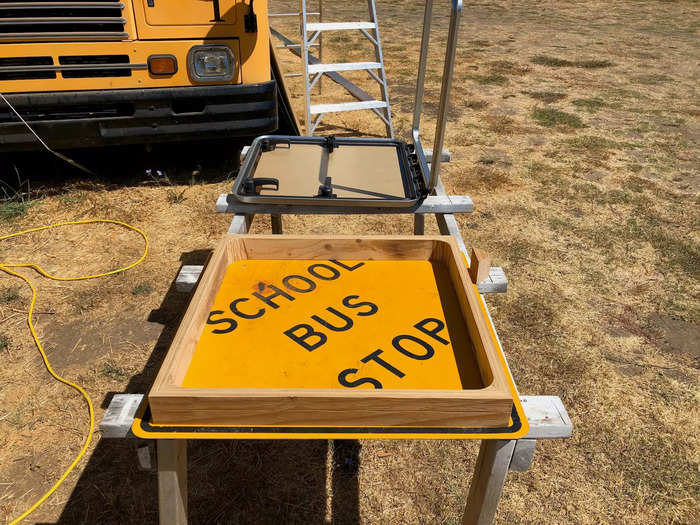
It was the "unicorn bus," said Beaman, adding that it filled all their requirements.
It had only been used for four years, ran like it was new, and was the exact size they wanted.
At 30 feet long, Beaman said it was small enough to park in state parks but large enough for them to live in it comfortably.
Also, having been used by an elementary school, it was especially safe.
"It's built like a tank," Beaman said. "It's designed to stay intact even in the event of an accident."
The process of converting it into a home took around four years. They're glad they took their time.
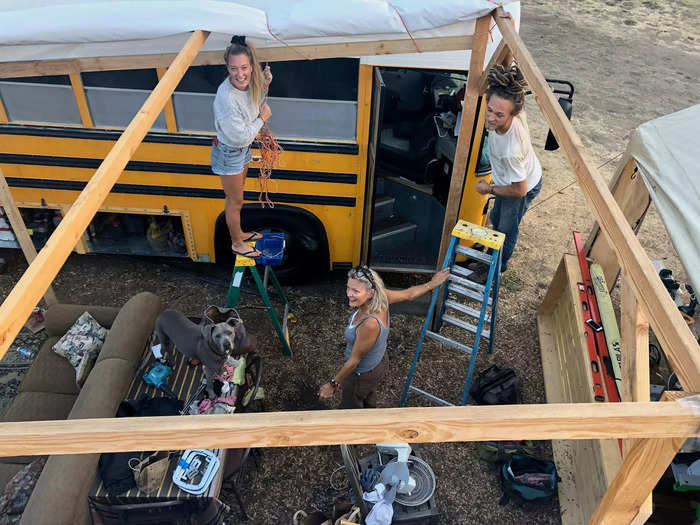
Overall, the project took about four years. The couple said they are glad they didn't rush it.
Morgan said: "If you want to really enjoy this lifestyle and you really want to build a home or a weekend travel space that you're going to love… take your time."
She added: "You have to be patient."
Beaman said that while they entered it with a vision, elements of it evolved over the process.
"We had a pretty clear idea," he said. "We didn't know exactly the finishes we would choose, I think that changed a little over time."
Taking it slow meant they could take their time finding bargains. The couple searched far and wide for cheap materials.

People tend to rush into these renovations, Morgan said.
"You kind of narrow yourself down," she added. "We are good at research, being patient, and finding exactly what we want, as long as that's going to take."
Beaman told Business Insider that Morgan had a knack for finding a discount.
"A lot of the light fixtures and things like that are what Anna found," he said.
Morgan used Craigslist, estate sales, and even managed to get some materials for free.
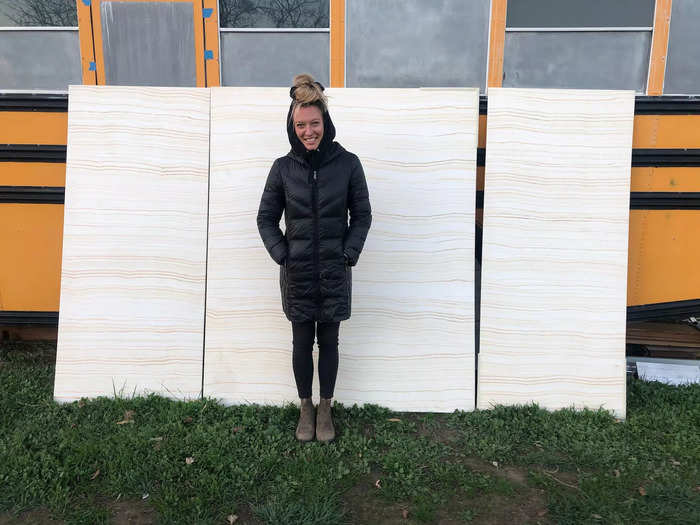
Morgan said the Brazilian Cherry wood, which is normally very costly, practically fell in their laps.
While working on a carpentry job, a painter on the project heard they were renovating a bus and offered the luxury wood to them for free.
Much of the other material came from Craigslist, eBay, estate sales, and contractors' sales.
They did all the work themselves.
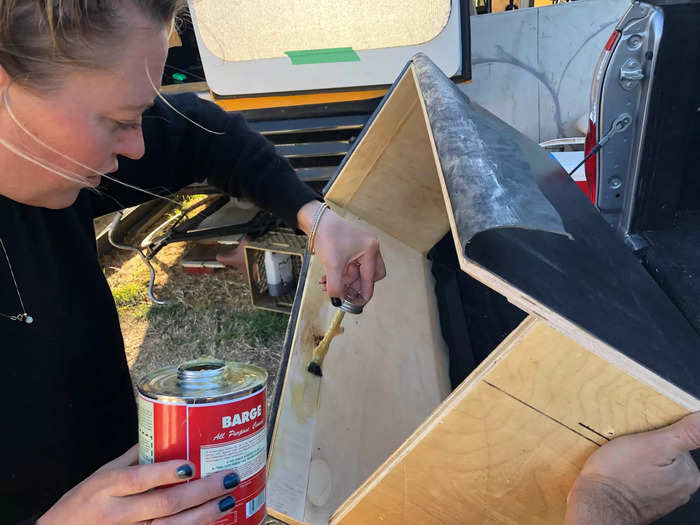
Beaman said they took on the entirety of the project themselves — designing, sourcing the materials, and the build itself.
He said they received a "little bit of help here and there" with certain tasks, but added that they didn't outsource a single thing.
In total, it cost them around $20,000.
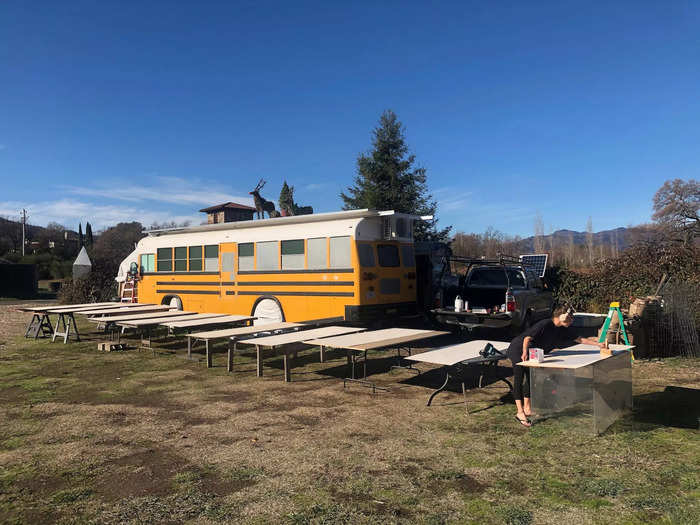
Including the $4,000 initial cost of the bus, the conversion cost them around $20,000, the couple said.
But it would have cost others doing exactly the same thing a lot more, they cautioned.
They saved a lot of money by using their skills as carpenters.
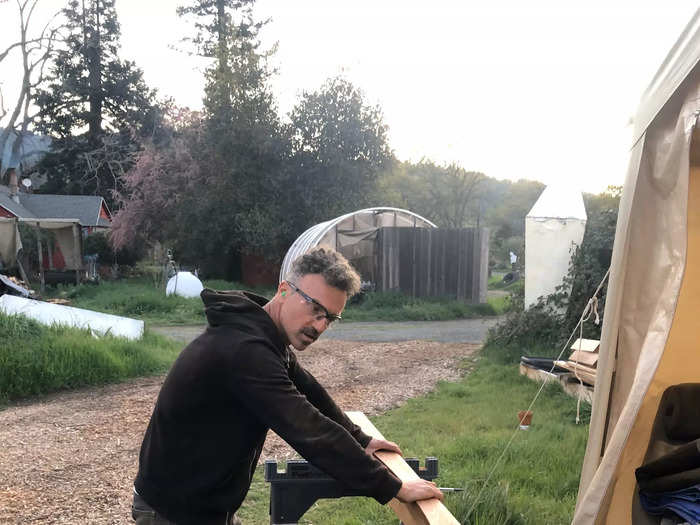
Beaman has spent most of his life honing his skills as a carpenter, a trade he learned from his father.
Around eight years ago, Morgan started working with Beaman and also doing carpentry jobs.
Beaman said that being in the trade saved them huge amounts of money, meaning the $20,000 tag could be misleading to others hoping to pursue a similar renovation.
He told BI: "Someone that's starting to do this build without those skills, they might have to outsource a lot more.
"We have the skills, and we have a source of material like leftover wood from jobs, that sort of thing. We were able to make that really work to our advantage."
They could also use their own tools, saving even more cash.
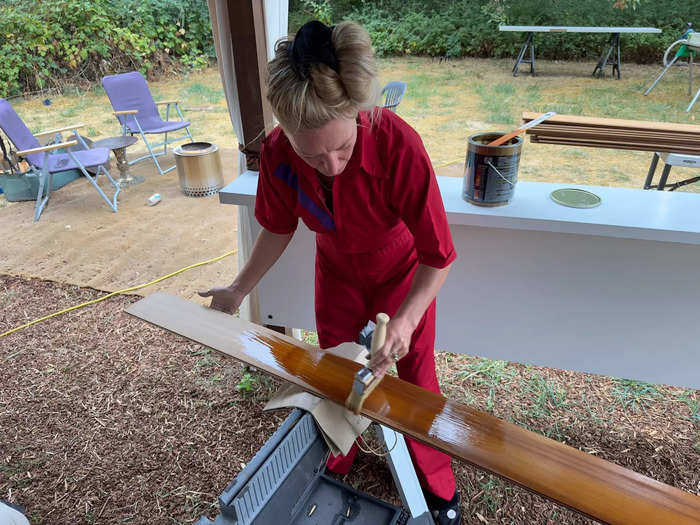
The couple had all the tools they needed owing to their jobs in carpentry, saving them from having to buy or rent equipment, like others might need to.
"We didn't have to buy a lot of tools to make this build happen because it's already things we're accustomed to using and have readily available," Beaman said.
One area they tried to outsource was getting solar panels installed. But they ended up teaching themselves how to do it.
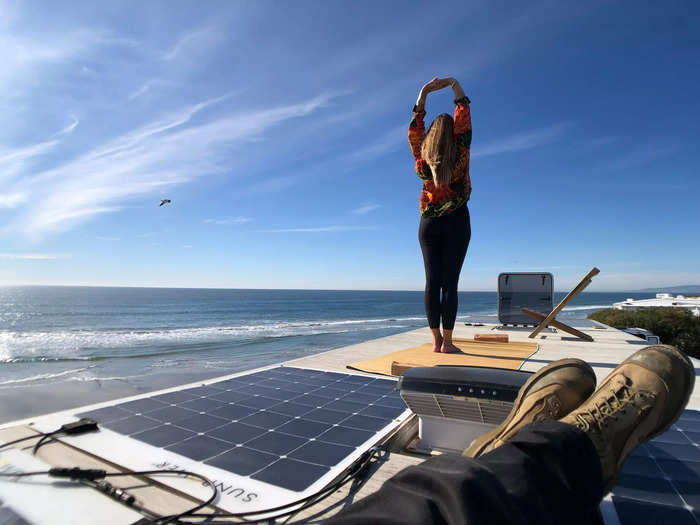
The couple initially sought to outsource the solar panel installation, hoping to find someone else to handle the setup.
However, Beaman explained they couldn't find a suitable installer because local professionals focused on residential setups, not off-grid systems like theirs.
In the end, they took it on themselves, relying on YouTube tutorials and research to make sense of the process, which Beaman said involved "looking at diagrams, learning about electricity."
Opting for top-tier components, they discovered discounted leftover panels on eBay, priced at $150 each.
Beaman added that this was a significant saving compared to the regular cost of nearly $2,000 a panel.
They also taught themselves about plumbing.
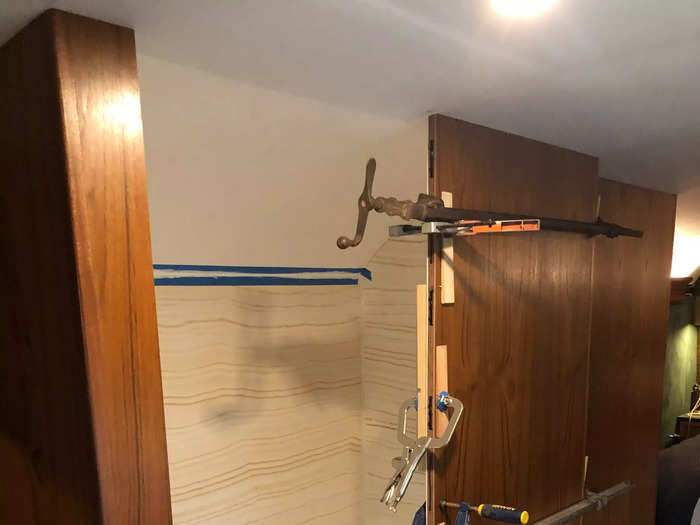
Morgan said that teaching themselves how to do the plumbing was a "huge learning curve," which took them a long time to figure out.
But beyond making the wet room functional, the couple was equally focused on the visual appeal of it.
Morgan told BI: "It was really important that everything felt beautiful and it felt us and that we enjoy walking into every space daily."
To make the small space feel larger than it is, Morgan said they tried to keep it as light as possible, using a natural-colored material they found on Craiglist for the walls.
The couple is still working out how to perfect certain aspects of the bus.
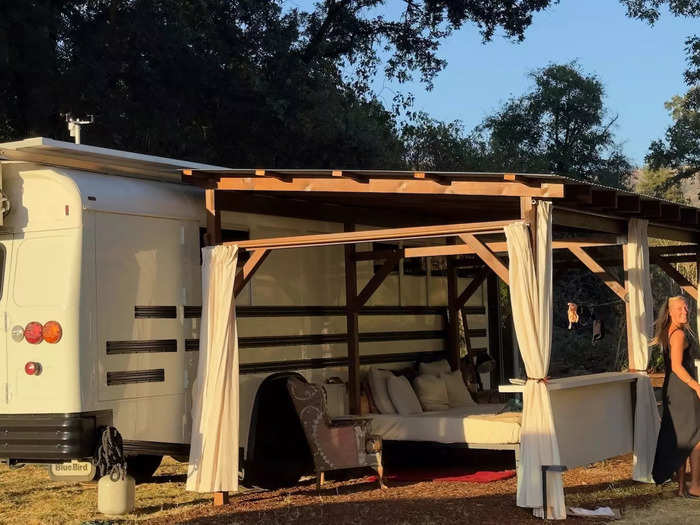
The couple has yet to find a permanent retractable awning to make the most of the outdoors while on the road.
Morgan said they've been looking for one for five years.
As a temporary measure, they've built a wooden awning with a tin roof which they can use while they are parked at home. The structure allows them to relax and even sleep outdoors.
Building the roof deck was complicated, they said, but they achieved what they wanted.
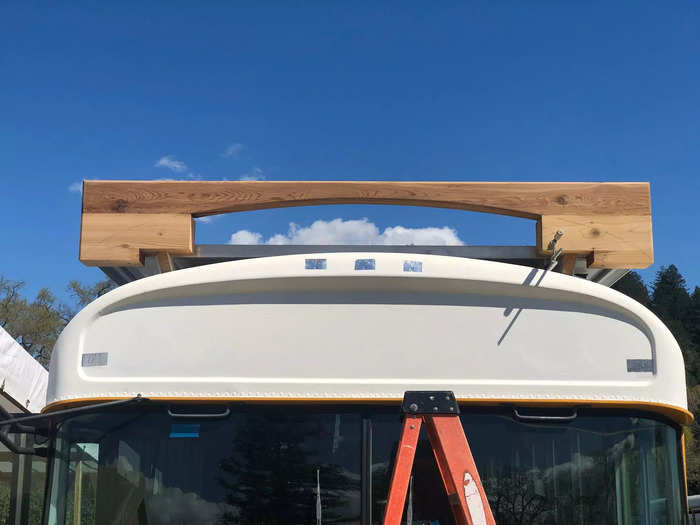
Beaman highlighted that constructing the roof deck was one of the biggest challenges during the build.
Various considerations came into play, such as having space to mount the solar panels, ensuring the roof deck could be used as a place to hang out, and maintaining a "low-profile" design.
The latter was particularly important because they travel in areas with overhanging tree branches and low power lines, Beaman told BI.
In the end, they found a design that worked, using aluminum L-brackets that run front to back, bolted in place.
They also had to get creative to make sure their bed fit properly.
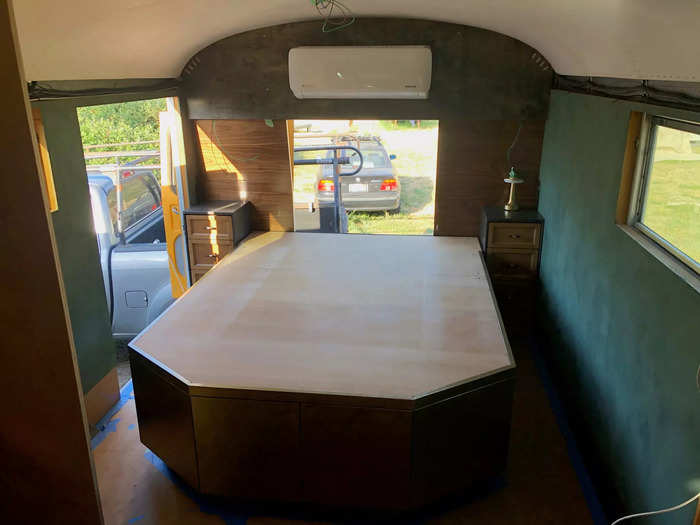
When fitting a bed into the bus, the couple wanted to make sure there was enough space to walk on both sides of it.
Beaman said they didn't want to have "somebody crawling over the top of the other person to get to their side of the bed."
So, they got creative. They decided to center the bed and cut the corners of both the platform and the mattress.
Morgan said she used a knife to cut the foam off the mattress before resewing the cover.
"It created the perfect walk space back to our nightstands on the sides of the bed," she added.
There's lots of storage under the bed.
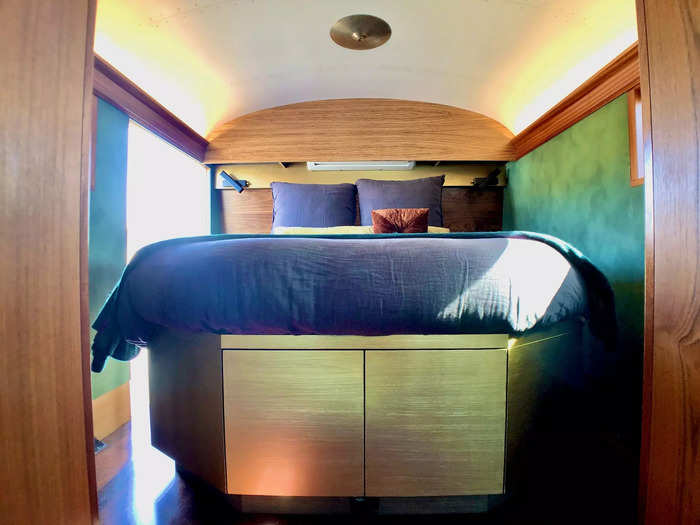
There is a lot of hidden storage space in the bedroom.
At the foot of the bed is space for linen, extra towels, and other items. Each side has drawers for added storage.
The platform itself serves as a storage space for a diesel heater, a feature Morgan described as "amazing" because it keeps them warm throughout winter.
The tiny kitchen has a surprising amount of features.
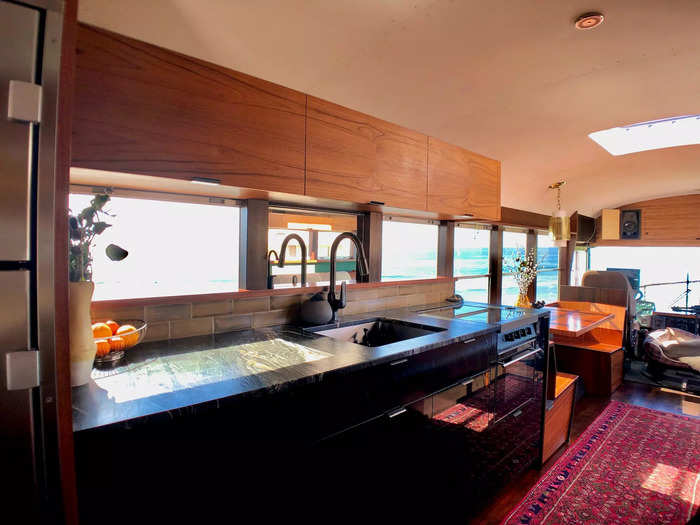
There's a pullout trash can, an under-sink filtration system for filtered water, an oven, three burners on the hob, a toaster oven, and a quartzite countertop.
"I do cook almost every single one of our meals there," said Morgan. "It's wonderful to cook in, it's really all we need."
The couch also has multiple uses.
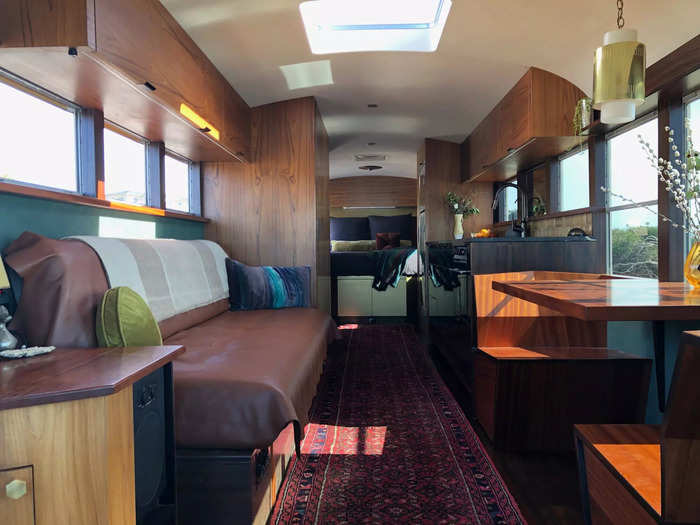
Beneath the couch, electrical components are discreetly tucked away. Accessing the controls for tasks like circuit maintenance or shutting down the refrigerator is straightforward, Beaman told BI.
Additionally, the entire couch is mounted on heavy-duty drawer slides, which means it can easily be pulled out and turned into a bed.
"It was really some feat of engineering," Beaman said.
The couple spent a long time designing their perfect chairs.
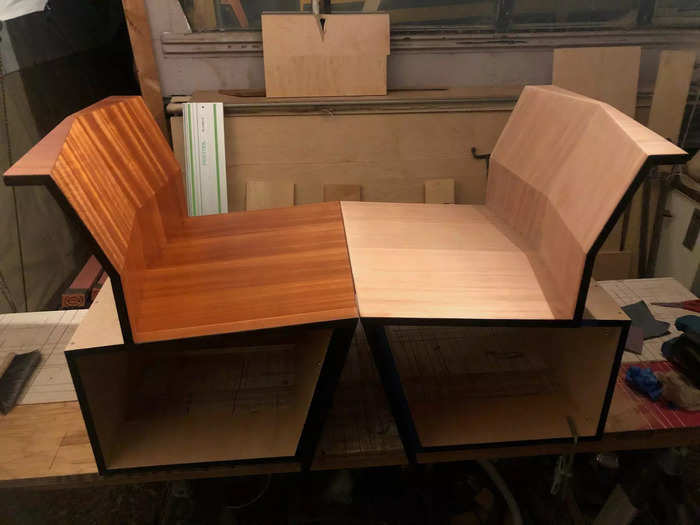
The couple said they wanted to have nice chairs that didn't need a cushion to be comfortable, largely because they don't find cushions visually pleasing.
"It's ribbon-striped African mahogany, and it's gorgeous, I'm not going to put foam and fabric," Beaman said.
They tried out more than a hundred chairs, noting what aspects of each they liked, which informed their own design.
In addition to the furniture, the curved ceiling gives it a mid-century flair.
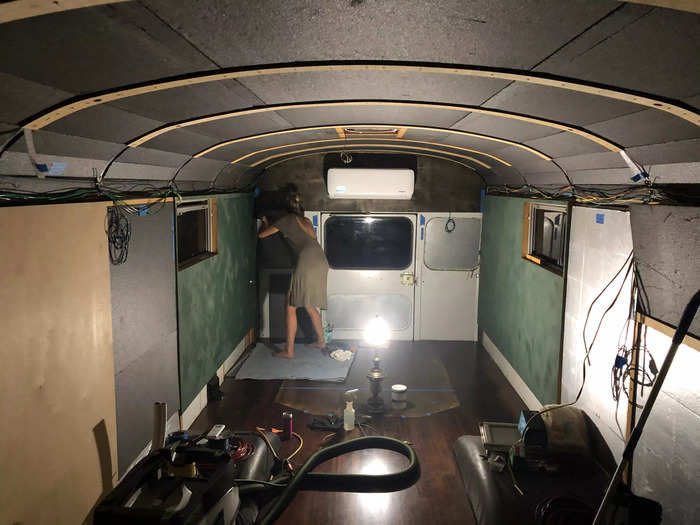
The couple curved the ceiling, which Beaman said gives the bus a "mid-century" flair.
"Mid-century is generally clean lines with subtle curvature," he told BI.
They said it also has Scandinavian influences.
The bus can function as a music studio.
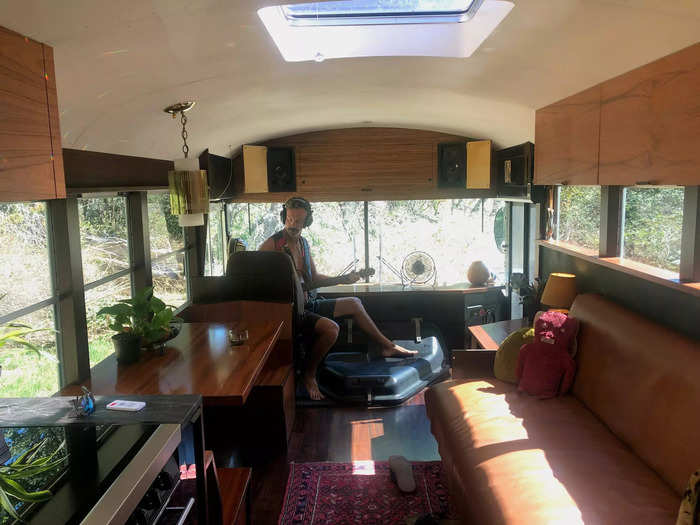
Beaman and Morgan are both musicians, so it was important to them to have music facilities on the bus.
There was, of course, limited space for this.
When they are parked, Beaman rests his laptop on the steering wheel. The area above, which was previously an old cabinet, was rebuilt to house the studio-reference monitors.
The speakers were angled in a specific way, with acoustics in mind, to ensure that sound quality wasn't being affected.
"We play music together so we do use the studio when we practice, right here in the bus, and it gets used a lot in that way as well," Morgan said.
The couple plans to continue traveling. They're enjoying life on the road.
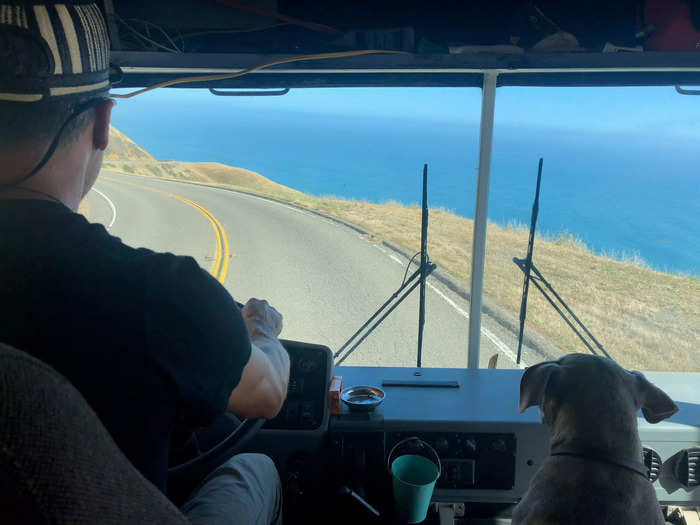
"We definitely want to continue to travel," Morgan said. "I think we really enjoy the warmer weather, especially living this type of lifestyle, it's definitely easier in warmer climates."
This means that in the winter they enjoy traveling in southern California and Mexico to make the most of the hotter temperatures.
They also plan to buy a piece of land to build a community of 'people on the move.'
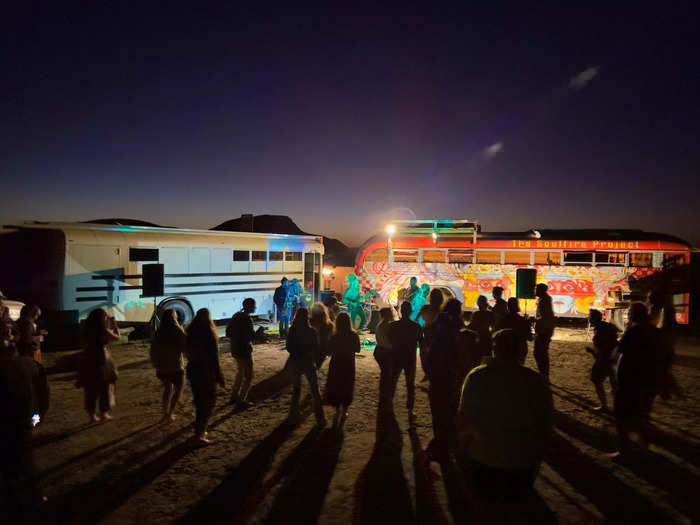
Morgan said they'd like to buy their own piece of land and "create a space for like-mind people to come together, park, reside in some capacity."
Beaman said the "community of travelers, of people on the move" is inspired by hostels they'd visited in Central America.
He added: "We have a good understanding of this lifestyle now, and we would like to provide that for other people."
Their main piece of advice is to really think about what you're doing before you decide to embark on van life.
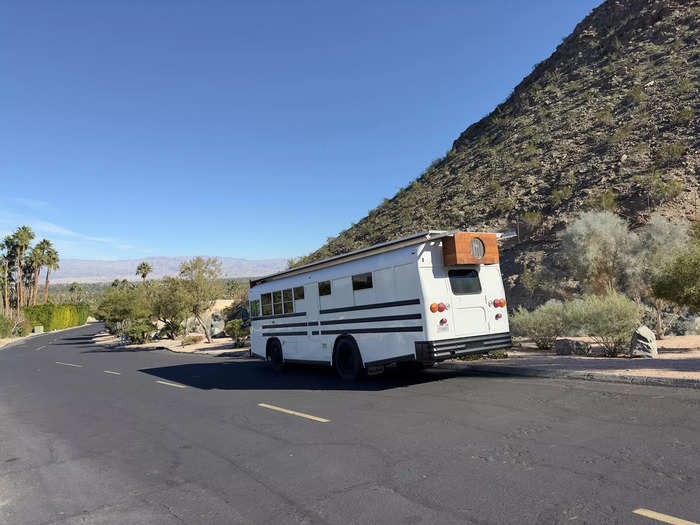
Beaman said he's come across countless people, inspired by videos they've seen online, who decided they want to flip a school bus and live in it.
"They buy the first bus that comes their way, spend all this time and money, and I end up seeing these for sale six months or a year later because they got in over their head," he said.
His advice would be to make sure you're buying the right vehicle, consider how you would use the space, where you would park it, and ultimately analyze whether the lifestyle is for you.
"Once you analyze all that," he said, "you have the best chance at success."
Popular Right Now
Popular Keywords
Advertisement